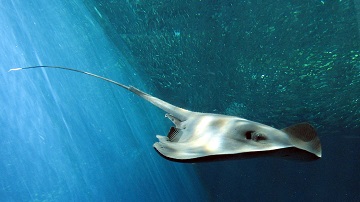610621-Research Assistant.jpg

Scientists in Japan reported that sting rays and electric rays might help map the ocean floor. Credit: Makoto Nakashima, CC BY-SA 2.0
When researchers at Oregon State University were studying the rumbling of Earth’s crust about a hundred miles offshore, they noticed something interesting. Whenever fin whales were around, they got some especially strong signals. So they’ve suggested that the whales might make good research assistants -- they could help probe the ocean floor and below.
That’s not the only way in which marine creatures could help us learn about the bottom of the sea. Scientists in Japan reported that sting rays and electric rays might help map the ocean floor.
The scientists tested how it might work, first in the lab, then off the coast of Okinawa. They stuck tiny instruments to the skin of the rays. The instruments included video cameras and “pingers” -- devices that sent out pulses of sound. Instruments on the surface used the sound waves to track the position of the rays. Video from the cameras was then synched with those readings to make 3-D images of the ocean floor.
The whale experiments used only the natural calls emitted by fin whales -- the second-biggest whales on the planet. Their songs are loud and deep. The sound waves travel through the sediments and rocks on the bottom. Instruments recorded the sound waves and converted them to images of the crust.
The view wouldn’t be as sharp as those made with other techniques. But the whales range all across the world -- making them good “assistants” for studying the crust at the bottom of the sea.

